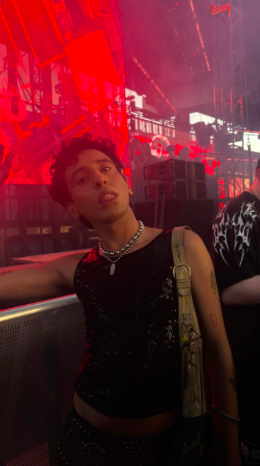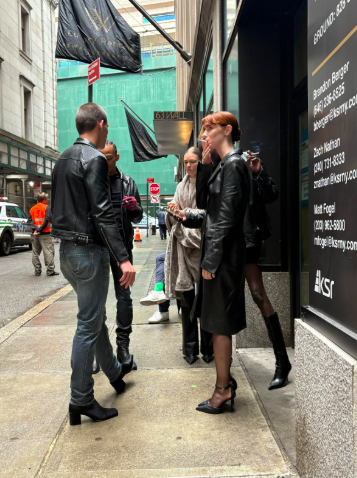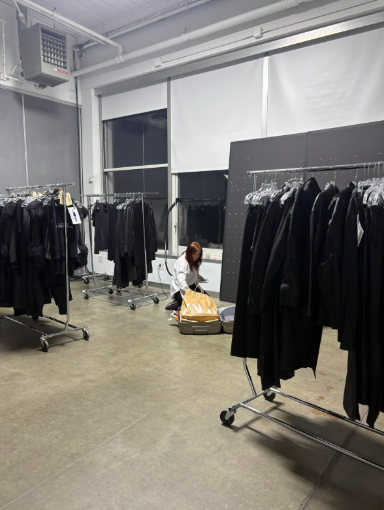
By Zohra Takal
Somewhere between the rush of subways and the sound of people rushing to work, there is a city where people dress to be seen. New York is everyone’s fashion fantasy. New York Fashion Week, fictional style icons like Carrie Bradshaw and Miranda Priestley, who doesn’t love New York?
In the little big city, Sahil Babar (22), also known as Duckie, originally from Pakistan, plays more than just a role in shaping what individuality looks like. His style lives between Prague’s quiet innovations and New York’s exuberant persona.

It’s late evening in Dublin, but a late, warm afternoon in New York City. Our screens flicker in different lights, mine dark and gritty, his bright, blaring. We begin to discuss how a life so split between different continents can be sewn together through style.
“Prague shaped my style way more than New York ever did,” he says,
Recalling how growing up in Prague, the golden city of a hundred spires, made him realise that everyone has more individuality. They’re forced to “get creative with how they look” and “acquire things they want” because of the scarcity of “ready-made ‘cool’ clothes.”
New York, he says, is less authentic. “Everyone’s on this journey to individualism,” yet the obsession with image makes people lose “their sparks and what makes them special.” It’s a paradox I’ve felt too, even outside of New York, in all the places I’ve been to, lived in, this idea that we need to be cool, unique, measuring originality by algorithms and approval.

“Fashion is about letting go, and that sentiment has been completely abandoned.” He says
When I ask him what drew him to fashion and styling, his answer shifts from commentary to memory. “For a lot of my life, I was obsessed with films, plays, anything visually stimulating,” he says. “I grew up heavily on Tumblr, consuming media full of subcultures, clothing I’d never seen before, and esoterically adorned divas.” Although acting was his initial path, he soon realized he wanted something “more hands-on.” There’s no trace of regret in his voice, only certainty of someone who has found where they belong.
And just like all of us, choosing a path that often branches, embracing the future and the opportunities that come.
When I ask about his influences, his answers reveal a dynamic that blends a timeless mixture. “Gabriette, French mimes from the ’20s, Angelina Jolie in the ’90s, Margiela by Galliano, Yoshitomo Nara.” But of course, he smiles, “the girls and boys I see strutting their stuff every day.”
As Sahil thinks about his creative process when styling or shooting a client, I take a moment,
This conversation made me think of all the times I was influenced by real people around me. We hear the word ‘Influencers’ and think of celebrity titles and follow counts, but the real transformations we make come from the people we see in our personal lives, when we walk into cafés or niche thrift stores.
“Usually we have to focus on a plan at first,” he says, mood boards, endless emails, pulling pieces from showrooms and stores. But beneath this complex operation lies the art: “You are building a character, which helps you understand what the job really requires.” Each job or project, he says, has its own beauty and stories; it’s unpredictable, and never the same twice.

He adds that his professors encourage them to take advantage of every opportunity that comes their way, having stylists who bring him on shoots.
As the evening progresses, the conversation drifts from logistics to the New York scene. Suddenly, it feels less like an interview and more like two people trying to decode what makes New York, New York.
When envisioning New York as an outfit, Sahil is quick to say “Miista Boxing Boot, Reformation Black Jeans, Off the shoulder black top, and big leather jacket, and a slouchy, worn-in big purse.”
When I ask if fashion should be political or purely aesthetic, he instantly replies, “Fashion is political regardless of how much someone tries to distance themselves from that.” He adds that “Vivienne Westwood, John Galliano, Ann Demeulemeester — they have all leaned into their political standings. Politics show brand identity, and that’s what people lean into.”
It’s the kind of answer that reminds me why fashion is more than fabric; it’s a language, identity, and a form of resistance.
“What’s been your biggest pinch-me moment so far?” I ask.
He barely pauses. “Working with Alex Consani and Amelia Gray on the Zara x Ludovic de Saint Sernin collection coming out soon,” he quickly adds, “and on Pink Pantheress’s new music video with JT.” He laughs, almost in disbelief. “I’m excited to see what’s next.”
Soon enough, New York slips calmly into dusk, golden lights turned neon.
I ask him one last question, where he sees himself in 5 years.
“Hopefully working full-time in film and TV styling,” his voice isn’t just a dream or hesitation, it’s direction. “And delving into that full-time.”
Just like that, as we end the call, I realise that for Sahil, style is more than what we wear, but how we thread our past lives, cultures, and people we’ve met into the people we are becoming.